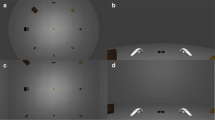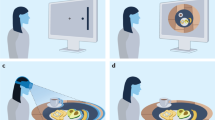Abstract
Recent findings from spatial cognition and cognitive neuroscience suggest that different types of mental representations could mediate the off-line retrieval of spatial relations from memory and the on-line guidance of motor actions in space. As a result, a number of models proposing multiple systems of spatial memory have been recently formulated. In the present article we review these models and we evaluate their postulates based on available experimental evidence. Furthermore, we discuss how a multiple-system model can apply to situations in which people reason about their immediate surroundings or non-immediate environments by incorporating a model of sensorimotor facilitation/interference. This model draws heavily on previous accounts of sensorimotor interference and takes into account findings from the stimulus–response compatibility literature.



Similar content being viewed by others
Notes
We thank David Waller for bringing this to our attention.
References
Amorim MA, Glassauer S, Corpinot K, Berthoz A (1997) Updating an object’s orientation and location during nonvisual navigation: a comparison between two processing models. Percept Psychophys 59:404–418
Ansorge U, Wühr P (2004) A response-discrimination account of the Simon effect. J Exp Psychol Hum Percept Perform 30:365–377
Avraamides MN, Ioannidou LM, Kyranidou MN (2007) Locating targets from imagined perspectives: comparing labelling with pointing responses. Q J Exp Psychol (in press)
Avraamides MN, Kelly JW (2005) Imagined perspective-changing within and across novel environments. In: Freksa C, Nebel B, Knauff M, Krieg-Brückner B (eds) Lecture notes in artificial intelligence: spatial cognition IV, reasoning, action, interaction. Springer, Berlin, pp 245–258
Avraamides MN, Klatzky RL, Loomis JM, Golledge RG (2004a) Use of cognitive vs. perceptual heading during imagined locomotion depends on the response mode. Psychol Sci 15:403–408
Avraamides M, Loomis JM, Klatzky RL, Golledge RG (2004b) Functional equivalence of spatial representations derived from vision and language: evidence from allocentric judgments. J Exp Psychol Learn Mem Cogn 30:801–814
Bächtold D, Baumüller M, Brugger P (1998) Stimulus–response compatibility in representational space. Neuropsychologia 36:731–735
Burgess N (2006) Spatial memory: how egocentric and allocentric combine. Trends Cogn Sci 10:551–557
Byrne P, Becker S, Burgess N (2007) Remembering the past and imagining the future: a neural model of spatial memory and imagery. Psychol Rev 114:340–375
Coles MGH, Gratton G, Bashore TR, Eriksen CW, Donchin EA (1985) Psychophysiological investigation of the continuous flow model of human information processing. J Exp Psychol Hum Percept Perform 11:529–553
De Jong R, Liang CC, Lauber E (1994) Conditional and unconditional automaticity: a dual-process model of effects of spatial stimulus–response correspondence. J Exp Psychol Hum Percept Perform 20:731–750
Easton RD, Sholl MJ (1995) Object-array structure, frames of reference, and retrieval of spatial knowledge. J Exp Psychol Learn Mem Cogn 21:483–500
Eimer M, Hommel B, Prinz W (1995) S–R compatibility and response selection. Acta Psychol 90:301–313
Fajen BR, Warren WH (2003) The behavioral dynamics of steering, obstacle avoidance, and route selection. J Exp Psychol Hum Percept Perform 29:343–362
Farrell JJ, Thomson JA (1999) On-line updating of spatial information during locomotion without vision. J Mot Behav 31:37–53
Fitts PM, Deininger RL (1954) S–R compatibility: correspondence among paired elements within stimulus and response codes. J Exp Psychol 48:483–492
Franklin N, Tversky B (1990) Searching imagined environments. J Exp Psychol Gen 119:63–76
Georgopoulos AP, Lurito JT, Petrides M, Schwartz AB, Masscy JT (1989) Mental rotation of the neuronal population vector. Science 243:234–236
Gibson JJ (1979) The ecological approach to visual perception. Houghton–Mifflin, Boston
Gladwin T (1970) East is a big bird: navigation and logic on the puluwat atoll. Harvard University Press, Cambridge
Goodale MA, Jakobson LS, Keillor JM (1994) Differences in the visual control of pantomimed and natural grasping movements. Neuropsychologia 32:1159–1178
Gratton G, Coles MGH, Sirevaag EJ, Eriksen CW, Donchin E (1988) Pre- and post stimulus activation of response channels: a psychophysiological analysis. J Exp Psychol Hum Percept Perform 14:331–344
Hartley T, Burgess N (2005) Complementary memory systems: competition, cooperation, and compensation. Trends Neurosci 28:169–170
Hodgson E, Waller D (2006) Lack of set size effects in spatial updating: evidence for offline updating. J Exp Psychol Learn Mem Cogn 32:854–866
Holmes MC, Sholl MJ (2005) Allocentric coding of object-to object relations in over-learned and novel environments. J Exp Psychol Learn Mem Cogn 31:1069–1087
Hommel B (2002) Responding to object files: automatic integration of spatial information revealed by stimulus–response compatibility effects. Q J Exp Psychol 55A:567–580
Kelly JW, Loomis JM, Avraamides MN (2007) Sensorimotor alignment effects in learning and novel environments. J Exp Psychol Learn Mem Cogn (in press)
Klatzky RL, Loomis JM, Beall AC, Chance SS, Golledge RG (1998) Spatial updating of self-position and orientation during real, imagined, and virtual locomotion. Psychol Sci 9:293–298
Kornblum S, Hasbroucq T, Osman A (1990) Dimensional overlap: cognitive basis for stimulus–response compatibility—a model and taxonomy. Psychol Rev 97:253–270
Loomis JM, Da Silva JA, Fujita N, Fukusima SS (1992) Visual space perception and visually directed action. J Exp Psychol Hum Percept Perform 18:906–921
Loomis JM, Lippa Y, Klatzky RL, Golledge RG (2002) Spatial updating of locations specified by 3-D sound and spatial language. J Exp Psychol Learn Mem Cogn 28:335–345
Loomis JM, Beall AC (2004) Model-based control of perception/action. In: Vaina L, Beardsley S, Rushton S (eds) Optic flow and beyond. Kluwer, Boston, pp 421–441
Loomis JM, Beall AC, Macuga KL, Kelly JW, Smith RS (2006) Visual control of action without retinal optic flow. Psychol Sci 17:214–221
May M (1996) Cognitive and embodied modes of spatial imagery. Psychol Beitr 38:418–434
May M (2004) Imaginal perspective switches in remembered environments: transformation versus interference accounts. Cogn Psychol 48:163–206
May M (2007) Imaginal repositioning in everyday environments: effects of testing method and setting. Psychol Res 71:277–287
McNamara TP (2003) How are the locations of objects in the environment represented in memory? In: Freksa C, Brauer W, Habel C, Wender KK (eds) Spatial cognition III: routes and navigation, human memory and learning, spatial representation and spatial reasoning, LNAI 2685. Springer, Berlin, pp 174–191
Milner AD, Goodale MA (1995) The visual brain in action. Oxford University Press, New York
Mou W, McNamara TP (2002) Intrinsic frames of reference in spatial memory. J Exp Psychol Learn Mem Cogn 28(1):162–170
Mou W, McNamara TP, Valiquette CM, Rump B (2004) Allocentric and egocentric updating of spatial memories. J Exp Psychol Learn Mem Cogn 30(1):142–157
Mou W, McNamara TP, Rump B, Xiao C (2006) Roles of egocentric and allocentric spatial representations in locomotion and reorientation. J Exp Psychol Learn Mem Cogn 32:1274–1290
Norman J (2002) Two visual systems and two theories of perception: an attempt to reconcile the constructivist and ecological approaches. Behav Brain Sci 25:73–96
Presson CC, Montello DR (1994) Updating after rotational and translational body movements: coordinate structure of perspective space. Perception 23:1447–1455
Riecke BE, van Veen HAHC, Bülthoff HH (2002) Visual homing is possible without landmarks–A path integration study in virtual reality. Presence Teleoperators Virtual Environ 11:443–473
Rieser JJ (1989) Access to knowledge of spatial structure at novel points of observation. J Exp Psychol Learn Mem Cogn 15(6):1157–1165
Rieser JJ, Guth DA, Hill EW (1986) Sensitivity to perspective structure while walking without vision. Perception 15:173–188
Rieser JJ, Garing AE, Young MF (1994) Imagery, action, and young children’s spatial orientation: it’s not being there that counts, it’s what one has in mind. Child Dev 65:1262–1278
Rock I (1983) The logic of perception. MIT Press, Cambridge
Schwartz SP, Pomerantz JR, Egeth HE (1977) Stale and process limitations in information processing: an additive factors analysis. J Exp Psychol Hum Percept Perform 3:402–410
Shelton AL, McNamara TP (1997) Multiple views of spatial memory. Psychonomic Bull Rev 4(1):102–106
Shelton AL, McNamara TP (2001) Systems of spatial reference in human memory. Cogn Psychol 43:274–310
Sholl MJ (2001) The role of a self-reference system in spatial navigation. In: Montello D (ed) Spatial information theory: foundations of geographic information science (International Conference, COSIT 2001 Proceedings). Lecture Notes in Computer Science, vol 2205. Springer, Berlin, pp 217–232
Sholl MJ, Kenny RJ, DellaPorta KA (2006) Allocentric-heading recall and its relation to self-reported sense-of-direction. J Exp Psychol Learn Mem Cogn 32:516–533
Simon JR (1969) Reactions toward the source of stimulation. J Exp Psychol 81:174–176
Snyder LH, Batista AP, Andersen RA (1997) Coding of intention in the posterior parietal cortex. Nature 386:167–170
Tagliabue M, Zorzi M, Umiltà C, Bassignani F (2000) The role of long-term memory and short-term-memory links in the Simon effect. J Exp Psychol Hum Percept Perform 26:648–670
Tlauka M, McKenna FP (1998) Mental imagery yields stimulus–response compatibility. Acta Psychol 98:67–79
Umiltà C, Zorzi M (1997) Commentary on Barber and O’Leary: learning and attention in S–R compatibility. In: Hommel B, Prinz W (eds) Theoretical issues in stimulus–response compatibility. North-Holland, Amsterdam, pp 173–178
Waller D, Hodgson E (2006) Transient and enduring spatial representations under disorientation and self-rotation. J Exp Psychol Learn Mem Cogn 32:867–882
Waller D, Montello DR, Richardson AE, Hegarty M (2002) Orientation specificity and spatial updating of memories for layouts. J Exp Psychol Learn Mem Cogn 28:1051–1063
Wang RF (2004) Between reality and imagination: when is spatial updating automatic? Percept Psychophys 66:68–76
Wang RF, Brockmole JR (2003a) Simultaneous spatial updating in nested environments. Psychon Bull Rev 10:981–98
Wang RF, Brockmole JR (2003b) Human navigation in nested environments. J Exp Psychol Learn Mem Cogn 29:398–404
Wang RF, Spelke ES (2000) Updating egocentric representations in human navigation. Cognition 77:215–250
Wang RF, Spelke ES (2002) Human spatial representation: insights from animals. Trends Cogn Sci 6:376–382
Werner S, Schmidt K (1999) Environmental reference systems for large-scale spaces. Spat Cogn Comput 1:447–473
Wolbers T, Hegarty Ms, Büchel C, Loomis J (2007) Update your environment: characterizing the neural system mediating visual spatial updating in humans. Paper presented at the 37th Annual Meeting of the Society for Neuroscience, San Diego, USA
Wraga M (2003) Thinking outside the body: an advantage for spatial updating during imagined versus physical self-rotation. J Exp Psychol Learn Mem Cogn 29:993–1005
Wühr P (2006) The Simon effect in vocal responses. Acta Psychol 121:210–226
Zorzi M, Umiltà C (1995) A computational model of the Simon effect. Psychol Res 58:193–205
Acknowledgments
We thank David Waller, Jack Loomis, Athanassios Raftopoulos, Marc Grosjean, and one anonymous reviewer for providing valuable comments and suggestions on an earlier draft of this manuscript. We also thank Roberta Klatzky for many useful discussions on this and related topics.
Author information
Authors and Affiliations
Corresponding author
Rights and permissions
About this article
Cite this article
Avraamides, M.N., Kelly, J.W. Multiple systems of spatial memory and action. Cogn Process 9, 93–106 (2008). https://doi.org/10.1007/s10339-007-0188-5
Received:
Revised:
Accepted:
Published:
Issue Date:
DOI: https://doi.org/10.1007/s10339-007-0188-5




